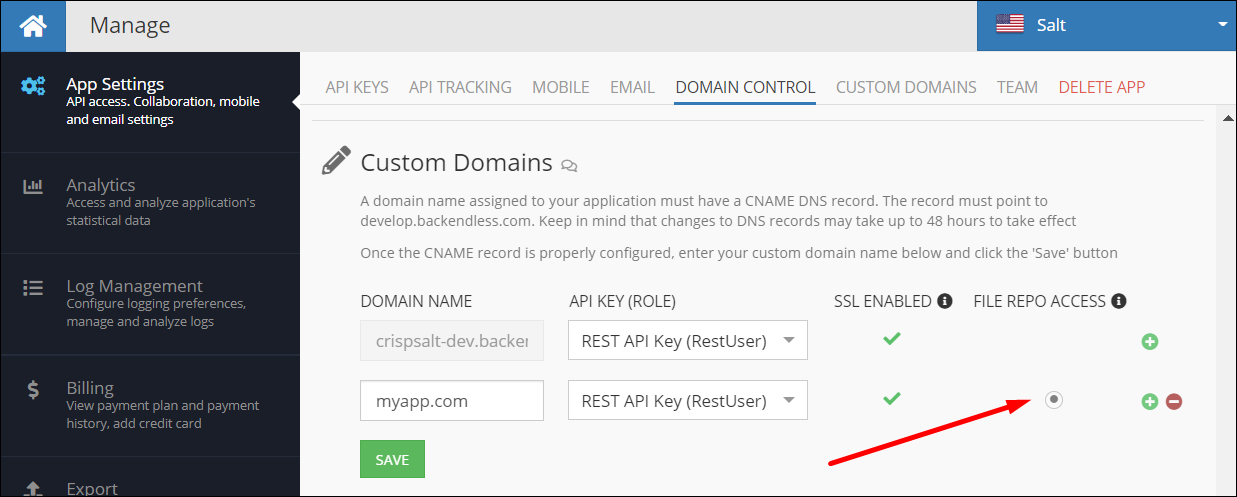File Upload¶
The file upload operation delivers a file in the Backendless file storage of your application. The return value of the upload operation is the public file URL. Backendless uses the following rules when assigning a URL to the uploaded file:
If no custom domains are mapped to the application, the URL has the following structure:
North American cluster:
https://backendlessappcontent.com/<application id>/<REST-API-key>/files/<path>/<file name>
European Union cluster:
https://eu.backendlessappcontent.com/<application id>/<REST-API-key>/files/<path>/<file name>
where:
| Argument | Description |
|---|---|
<application id> |
ID of the application which can be obtained from the Manage > App Settings screen of the Backendless Console |
<REST-API-key> |
REST API key of your application. You can get the value from the Manage > App Settings section of the Backendless Console. Note that if the file is created from Cloud Code (JS, Java or Codeless), the API key in the file path will be the CodeRunner API Key. |
<path> |
Directory path where the file is saved |
<file name> |
Name of the file |
If a custom domain is assigned to the application and the domain is selected for File Repo access, Backendless will use the custom domain to create a URL for the uploaded file. The File Repo access configuration is available in Backendless Console (Manage > App Settings > Custom Domains):
When a custom domain is assigned to handle files in your Backendless backend, the structure of the URL is as follows:
https://your-custom-domain.com/api/files/<path>/<file name>
Note that your xxxx.backendless.app subdomain cannot be assigned to handle File Repo access. This means that Backendless server will never assign that subdomain to the files in your Backendless file repo.
The URL assigned to a file and returned as a result of the upload operation accounts for any security permissions assigned to the file (or the folder it is located in).
Method¶
POST
Endpoint URL¶
The xxxx.backendless.app is a subdomain assigned to your application. For more information see the Client-side Setup section of this documentation.
https://xxxx.backendless.app/api/files/<path>/<filename>?overwrite=true
where:
| Argument | Description |
|---|---|
<path> |
Directory path in the Backendless file storage where the file should be stored. If the path does not exist, Backendless File Service creates the directory structure. |
<filename> |
Name of the file the upload is saved as. |
overwrite |
Defines whether a newly saved file overwrites the existing file. If the argument value is true, the new file overwrites the existing one. Otherwise, if the value is false or the overwrite parameter is not present, and another file with the same name already exists, the server returns an error. |
Request headers¶
Content-Type: multipart/form-data
user-token: optional value obtained as a result of the login operation.
where:
| Argument | Description |
|---|---|
Content-Type |
Must be set to multipart/form-data. This header is mandatory. |
user-token |
Optional header. Contains a value returned by Backendless in a preceding user Login API call. If user-token is set in the request, the currently logged in user will be assigned to the ownerId property of the user object which is being saved. Additionally, the operation will be executed with the security policy associated currently logged in user. This means all permissions associated with the user and the roles assigned to the user will be enforced by Backendless. |
Request Body:¶
File contents formatted per the multipart/form-data requirements.
Response Body¶
{
"fileURL" : file URL which should be used to download the file
}
Example¶
Important
Make sure to replace xxxx in the domain name in the sample request below to the one assigned to your application.
curl -H Content-Type:"multipart/form-data" \
--form upload=@test.txt \
-X POST \
-v http://xxxx.backendless.app/files/txtfiles/test.txt
Codeless Reference¶

where:
| Argument | Description |
|---|---|
source file URL |
A URL to the file that must be uploaded to the Backendless file storage. Note that you can use third-party cloud services URLs to upload files to the Backendless. |
target file path |
Path in the remote Backendless file storage where the content should be stored. |
overwrite |
The file is overwritten if the argument value is true and the file already exists. Otherwise, if the value is false and another file with the same name already exists, an error is returned. |
return uploaded file URL |
When this box is checked, the operation returns a URL to the file saved to the Backendless file storage. |
Returns the URL to the uploaded file.
For demonstration purposes, the example below downloads the file from the Dropbox and saves it to the /download folder in the Backendless file storage.

The result of this operation will look as shown below after the Codeless logic runs. As you can see the operation has downloaded and saved the image to the /download folder.
